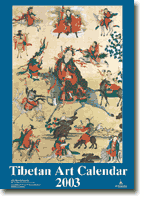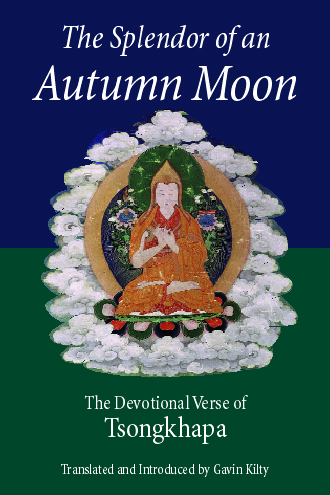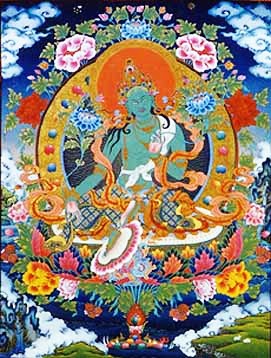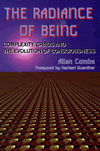The Blessed Arya Tara - Comments and Pointers Archive
 4
Jan 2003 - Happy New Year!
4
Jan 2003 - Happy New Year!
30 May 2002 Lati
Rinbochay & Denma Locho Rinbochay (Translations by Leah Zahler & Jeffrey
Hopkins). Meditative
States in Tibetan Buddhism. Wisdom Publications, 1996.
Lati
Rinbochay & Denma Locho Rinbochay (Translations by Leah Zahler & Jeffrey
Hopkins). Meditative
States in Tibetan Buddhism. Wisdom Publications, 1996.
The Goddess surely recommends this teaching and out of her great compassion will train you if you let her:
"Calm abiding is a state where the meditator sets his or her mind on an object of observation. Setting the mind on the object of observation is likened to tying an elephant to a post. The rope symbolizes mindfulness; the post symbolizes the object of observation; the elephant symbolizes the mind. It is said that if we tie the elephant of the mind to the post of an object of observation with the rope of mindfulness, we can achieve any good quality we want... Moreover, tying our minds to an internal object of observation is like tying up all external sources of harm, as well; external sources of harm will not be able to inflict damage...
"Now I will explain calm abiding in terms of a type of calm abiding that takes the body of a Buddha as its object of observaton... In order to develop calm abiding, one must overcome five faults. The first is laziness. The second is forgetting the instruction--that is, forgetfulness of the object of observation. The third is laxity. The fourth is non-application--that is, non-application of the antidotes to laxity and excitement. The last is overapplication of the antidotes to laxity and excitement...
"To overcome these five faults, there are eight applications--that is, antidotes, or remedies. There are four antidotes to laziness: faith, aspiration, exertion, and pliancy. The antidote to forgetting the instruction is mindfulness. The antidote to laxity and excitement is introspection. The antidote to non-application is application--that is, application of the antidotes--and the antidote to overapplication is equanimity--that is, desisting from application."
3 Mar 2002 Rinpoche,
Bokar. Tara
The Feminine Divine. Clearpoint Press, 1999.
Rinpoche,
Bokar. Tara
The Feminine Divine. Clearpoint Press, 1999.
Recently, I received a query by email that Bokar Rinpoche has the answer to in his excellent text on Tara.
Question: Generally, a "pure land," a paradise, is attributed to the deities and they dwell in it. What is Tara's pure land? Answer: Tara dwells, as Avelokatishvara, in the pure land of Potala, manifested on earth by a mountain in southern India. Nevertheless, a pure land is attributed to Tara. It is a particular domain, called "Harmony of Turquoise Leaves."
It doesn't do much good to have an intellectual understanding of this. The real question is how to experience Tara's pure land. Every Buddha creates a Buddha field and with meditation, devotion, and committment to the deity over many years, you may come to live in that Buddha field. Then you truly know where the pure land is.
8 Feb 2002 HH
Dalai Lama could use your help ...
HH
Dalai Lama could use your help ...
As you may know, after the recent hospitalization of HHDL, it has been suggested by his oracle that we accumulate 100 million Green Tara Mantra and or the 21 praises to Tara. As of 5 February there were 10 million accumulated. We don't know if this is a world-wide count or a national count. It is hoped that over the weekend the goal will be mostly achieved. If you are doing these practices either individually or in a group you can send your totals to annie@igc.org.
13 Jan 2002 - Meditation for the Week
In her aspect as Mother of the Buddhas, Tara has many great teachers as disciples, but few devotees who love her with all their hearts and dwell constantly in her presence. Those motivated by self improvement or the teaching/improvement of others may find more satisfying accomplishment in both aspects by dwelling on expanding love in their heart for her and capturing clearly her image in the mind as a continual practice.
 THE
SPLENDOR OF AN AUTUMN MOON, The Devotional Verse of Tsongkhapa
THE
SPLENDOR OF AN AUTUMN MOON, The Devotional Verse of Tsongkhapa A
student's page In Praise of Tara
A
student's page In Praise of Tara Greenwald,
Jeff. Shopping
for Buddhas. Lonely Planet, 1996.
Greenwald,
Jeff. Shopping
for Buddhas. Lonely Planet, 1996. Combs,
Allen. The
Radiance of Being: Complexity, Chaos, and the Evolution of Consciousness.
Paragon House, 1996.
Combs,
Allen. The
Radiance of Being: Complexity, Chaos, and the Evolution of Consciousness.
Paragon House, 1996.